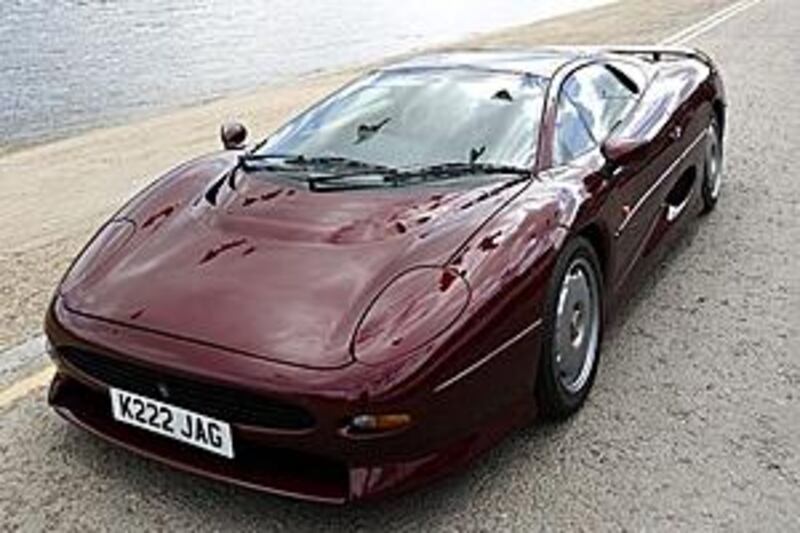Remember 1988? When greed was good, lunch was for wimps and Wall Street was showing at a cinema near you. Brightly coloured braces (or suspenders as Gordon Gekko called them) and hair slicked back with a tub of grease were de rigueur in the workplace. And money dominated everything: how much you were making, what bonus you were going to get, what you were going to spend it on?
The glamorous Jaguar XJ220 supercar was born into this world of overinflated expectations that same year at the UK's motor show, which had by the mid-Eighties moved from glitzy London to gritty Birmingham in the Midlands. Developed as a concept car by a group of the car maker's engineers over a nice cup of tea on a few rainy Saturday mornings, the powers that be at Jaguar were initially remarkably coy about the XJ220 making it into production.
"There are no plans to produce the car and no orders are being accepted for it. JaguarSport Ltd will review public reaction and assess the commercial viability of the project. Even limited production of such a vehicle would not be possible until the early 1990s," said an official statement released on the eve of the motor show in October, 1988. The public, predictably, went mad for that slippery body, those luscious scissor doors and the promised hyper performance of the 6.2L V12 engine capable of powering the car to a top speed in excess of 200mph.
This was the sort of carriage that would lead Britain's beleaguered car industry - humbled by Red Robbo's concerted campaign of industrial action and worker walkouts in the Seventies, humiliated by endless restructuring in the Eighties - back into the high life once more. Suitably emboldened by the biggest collective display of swooning in the Midlands since Sophia Loren had made an impromptu visit to Birmingham a few years earlier, Jaguar announced its intention to build 350 XJ220s, thus beginning an unseemly scramble from prospective buyers anxious to put down a £50,000 deposit.
Grown men sold their children, offsprings mortgaged their parents and when the dust settled, Jaguar proudly told anyone who would listen that the limited edition XJ220 was five times oversubscribed. Success assured. British car industry saved. End of story. Or it should have been, but the Jag joined an already long list of supercars on the market - Ferrari, Lamborghini and Porsche all had their own XJ220 equivalents. McLaren, Honda and Bugatti were busy rolling out new cars, and then there were talked-of models from fellow Brits Aston Martin and MG.
Even Giorgio Moroder, a record producer hitherto best known for being Together in Electric Dreams with Phil Oakey of The Human League, decided, for reasons best known only to himself, to launch his monster Cizeta-Moroder V16T supercar in 1988. You won't be surprised to know that story didn't end well, either. All of which meant Jaguar's paid-up customers, many of whom planned to flip their place on the XJ220's waiting list at a profit, began to get a bit miffed by production delays and significant changes to the car's specification as the car maker struggled to keep costs and expectations under control.
The promised V12 became a 3.5L V6 and the anticipated luxury interior now featured a liberal smattering of cabin plastics lifted directly from the humble Ford Escort, while the list price spiralled to £403,000 (Dh2.4m). Worse still, the economic bubble burst and the markets crashed (fancy that?). Predictably, the profit hunters deserted the XJ220 in droves. Jaguar ended up suing those customers who welshed on their contracts, those same punters countersued and, like a scene from a typically British farce, the car maker's finest hour turned into an unmitigated disaster.
The first XJ220s were eventually delivered to suitably nonplussed buyers in 1992, by which time, the world was now firmly in thrall to the peerless McLaren F1. Jaguar cancelled production without ever getting close to completing 350 cars. In fact, some examples remained unsold, unregistered and gathering dust until the end of the decade. Nevertheless, the XJ220 was, briefly, the fastest production car in the world and, like Sophia Loren could even today, still stop traffic in Birmingham.
And, just like the Italian screen siren, it was fantastically beautiful and properly high maintenance, neatly fitting the blueprint for the perfect supercar. motoring@thenational.ae







